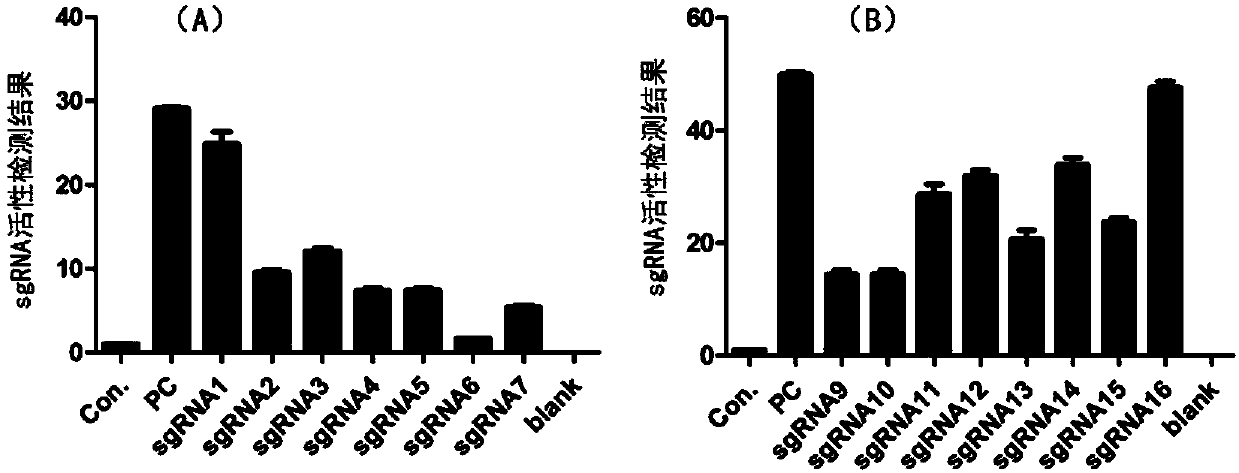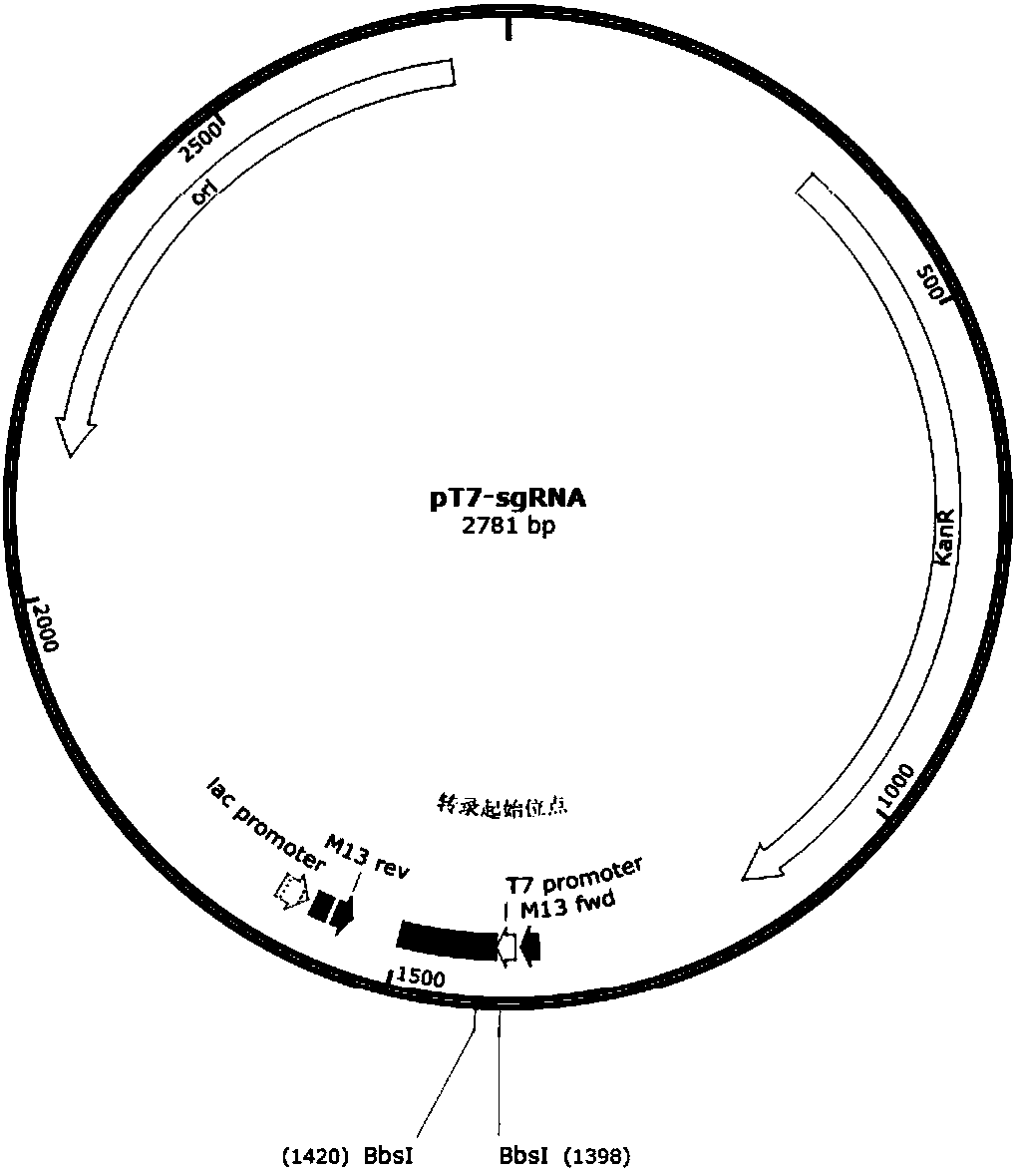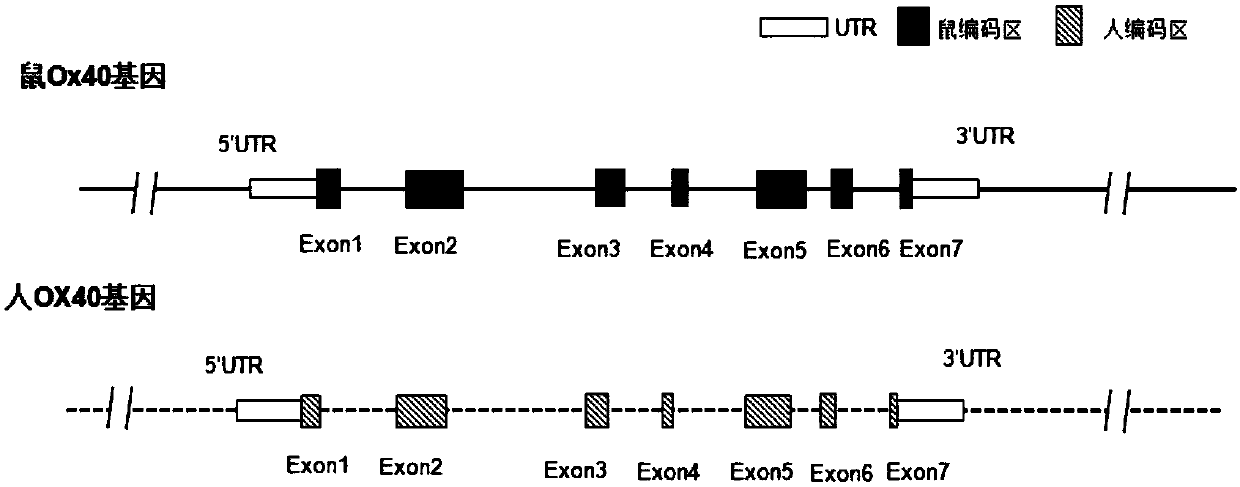Preparation method and application of humanized gene modification animal model
A technology of animal models and non-human animals, applied in botany equipment and methods, biochemical equipment and methods, plant genetic improvement, etc., to speed up the research and development process, reduce the risk of drug development, and save time and cost
- Summary
- Abstract
- Description
- Claims
- Application Information
AI Technical Summary
Problems solved by technology
Method used
Image
Examples
Embodiment 1
[0174] Example 1 Construction of pT7-OX-6 and pT7-OX-12
[0175] The target sequence determines the specificity of sgRNA targeting and the efficiency of inducing Cas9 to cut the target gene. Therefore, efficient and specific target sequence selection and design are the prerequisites for constructing sgRNA expression vectors.
[0176] Taking mice as an example, design and synthesize a guide RNA sequence that recognizes the 5'end target site (sgRNA1-sgRNA7) and the 3'end target site (sgRNA9-sgRNA16). According to the function and sequence characteristics of Ox40 gene, the 5'end target site and the 3'end target site are located on the second exon and fifth exon of the mouse Ox40 gene, respectively, and each sgRNA is the target site on Ox40 The point sequence is as follows:
[0177] sgRNA-1 target site sequence (SEQ ID NO:1): 5'-GTTAAACATACCTACCCCAGTGG-3'
[0178] sgRNA-2 target site sequence (SEQ ID NO: 2): 5'-CGACAGCACTTGTGACCACTGGG-3'
[0179] sgRNA-3 target site sequence (SEQ ID NO: ...
Embodiment 2
[0203] Example 2 Construction of vector pClon-4G-OX40
[0204] The main part of the mouse Ox40 gene (Gene ID: 22163) exon 1 to exon 5 (based on the transcript with NCBI accession number NM_011659.2→NP_035789.1, the mRNA sequence is as SEQ ID NO: 25, the corresponding protein sequence is shown in SEQ ID NO: 26) is replaced with the corresponding fragment of human OX40 gene (Gene ID: 7293) (based on the transcript with NCBI accession number NM_003327.3→NP_003318.1, the mRNA sequence is as The corresponding protein sequence is shown in SEQ ID NO: 27, and the corresponding protein sequence is shown in SEQ ID NO: 28), among which, the comparison diagram of mouse Ox40 and human OX40 is shown in image 3 , See the schematic diagram of the modified humanized mouse OX40 gene finally Figure 4 , The DNA sequence of humanized mouse OX40 gene (chimeric OX40 gene DNA) is shown in SEQ ID NO: 29:
[0205] TGTTAAACAT acatatcctagcaacgaccggtgctgccacgagtgcaggccaggtgaggcctcaggaggggtcgcca cgcacgggcac...
Embodiment 3
[0234] Example 3 Verification of vector pClon-4G-OX40
[0235] Randomly select 10 pClon-4G-OX40 clones and use 2 sets of enzymes for restriction enzyme digestion verification. Among them, EcoRI+ScaI should appear 4657bp+3296bp, HindIII+BglII should appear 4223bp+3116bp+614bp. See the enzyme digestion results Image 6 , Indicating that the plasmid numbers 1, 3, and 8 are digested correctly and the results are in line with expectations. Plasmids numbered 1 and 3 were verified by the sequencing company to be correct. Plasmid 3 was selected for subsequent experiments.
PUM
 Login to View More
Login to View More Abstract
Description
Claims
Application Information
 Login to View More
Login to View More - R&D
- Intellectual Property
- Life Sciences
- Materials
- Tech Scout
- Unparalleled Data Quality
- Higher Quality Content
- 60% Fewer Hallucinations
Browse by: Latest US Patents, China's latest patents, Technical Efficacy Thesaurus, Application Domain, Technology Topic, Popular Technical Reports.
© 2025 PatSnap. All rights reserved.Legal|Privacy policy|Modern Slavery Act Transparency Statement|Sitemap|About US| Contact US: help@patsnap.com



